Ethyl 2-(3,4-dimethoxyphenyl)acetate
Modify Date: 2024-01-04 12:15:52
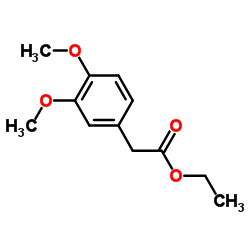
Ethyl 2-(3,4-dimethoxyphenyl)acetate structure
|
Common Name | Ethyl 2-(3,4-dimethoxyphenyl)acetate | ||
|---|---|---|---|---|
| CAS Number | 18066-68-7 | Molecular Weight | 224.253 | |
| Density | 1.1±0.1 g/cm3 | Boiling Point | 302.0±27.0 °C at 760 mmHg | |
| Molecular Formula | C12H16O4 | Melting Point | N/A | |
| MSDS | N/A | Flash Point | 129.3±23.8 °C | |
| Name | ethyl 2-(3,4-dimethoxyphenyl)acetate |
|---|---|
| Synonym | More Synonyms |
| Density | 1.1±0.1 g/cm3 |
|---|---|
| Boiling Point | 302.0±27.0 °C at 760 mmHg |
| Molecular Formula | C12H16O4 |
| Molecular Weight | 224.253 |
| Flash Point | 129.3±23.8 °C |
| Exact Mass | 224.104858 |
| PSA | 44.76000 |
| LogP | 2.23 |
| Vapour Pressure | 0.0±0.6 mmHg at 25°C |
| Index of Refraction | 1.494 |
| Storage condition | 2-8°C |
Synonym:Homoveratric acid, ethyl este Section 2 - COMPOSITION, INFORMATION ON INGREDIENTS
Risk Phrases: None Listed. Section 3 - HAZARDS IDENTIFICATION EMERGENCY OVERVIEW
Not available. Potential Health Effects Eye: May cause eye irritation. Skin: May cause skin irritation. May be harmful if absorbed through the skin. Ingestion: May cause irritation of the digestive tract. May be harmful if swallowed. Inhalation: May cause respiratory tract irritation. May be harmful if inhaled. Chronic: Not available. Section 4 - FIRST AID MEASURES Eyes: Flush eyes with plenty of water for at least 15 minutes, occasionally lifting the upper and lower eyelids. Get medical aid. Skin: Get medical aid. Flush skin with plenty of water for at least 15 minutes while removing contaminated clothing and shoes. Ingestion: Get medical aid. Wash mouth out with water. Inhalation: Remove from exposure and move to fresh air immediately. Notes to Physician: Treat symptomatically and supportively. Section 5 - FIRE FIGHTING MEASURES General Information: As in any fire, wear a self-contained breathing apparatus in pressure-demand, MSHA/NIOSH (approved or equivalent), and full protective gear. Extinguishing Media: Use water spray, dry chemical, carbon dioxide, or chemical foam. Section 6 - ACCIDENTAL RELEASE MEASURES General Information: Use proper personal protective equipment as indicated in Section 8. Spills/Leaks: Absorb spill with inert material (e.g. vermiculite, sand or earth), then place in suitable container. Section 7 - HANDLING and STORAGE Handling: Avoid breathing dust, vapor, mist, or gas. Avoid contact with skin and eyes. Storage: Store in a cool, dry place. Store in a tightly closed container. Section 8 - EXPOSURE CONTROLS, PERSONAL PROTECTION Engineering Controls: Use adequate ventilation to keep airborne concentrations low. Exposure Limits CAS# 18066-68-7: Personal Protective Equipment Eyes: Not available. Skin: Wear appropriate protective gloves to prevent skin exposure. Clothing: Wear appropriate protective clothing to prevent skin exposure. Respirators: Follow the OSHA respirator regulations found in 29 CFR 1910.134 or European Standard EN 149. Use a NIOSH/MSHA or European Standard EN 149 approved respirator if exposure limits are exceeded or if irritation or other symptoms are experienced. Section 9 - PHYSICAL AND CHEMICAL PROPERTIES Physical State: Liquid Color: dark Odor: Not available. pH: Not available. Vapor Pressure: Not available. Viscosity: Not available. Boiling Point: 191 deg C @25mmHg Freezing/Melting Point: Not available. Autoignition Temperature: Not available. Flash Point: Not available. Explosion Limits, lower: Not available. Explosion Limits, upper: Not available. Decomposition Temperature: Solubility in water: Specific Gravity/Density: Molecular Formula: C12H16O4 Molecular Weight: 224 Section 10 - STABILITY AND REACTIVITY Chemical Stability: Not available. Conditions to Avoid: Incompatible materials. Incompatibilities with Other Materials: Strong oxidizing agents, bases. Hazardous Decomposition Products: Carbon monoxide, carbon dioxide. Hazardous Polymerization: Has not been reported Section 11 - TOXICOLOGICAL INFORMATION RTECS#: CAS# 18066-68-7 unlisted. LD50/LC50: Not available. Carcinogenicity: Ethyl 2-(3,4-dimethoxyphenyl)acetate - Not listed by ACGIH, IARC, or NTP. Section 12 - ECOLOGICAL INFORMATION Section 13 - DISPOSAL CONSIDERATIONS Dispose of in a manner consistent with federal, state, and local regulations. Section 14 - TRANSPORT INFORMATION IATA No information available. IMO No information available. RID/ADR No information available. Section 15 - REGULATORY INFORMATION European/International Regulations European Labeling in Accordance with EC Directives Hazard Symbols: Not available. Risk Phrases: Safety Phrases: S 24/25 Avoid contact with skin and eyes. WGK (Water Danger/Protection) CAS# 18066-68-7: No information available. Canada CAS# 18066-68-7 is listed on Canada's NDSL List. CAS# 18066-68-7 is not listed on Canada's Ingredient Disclosure List. US FEDERAL TSCA CAS# 18066-68-7 is listed on the TSCA inventory. SECTION 16 - ADDITIONAL INFORMATION N/A |
| Hazard Codes | Xn,Xi |
|---|---|
| Risk Phrases | R22:Harmful if swallowed. R36/37/38:Irritating to eyes, respiratory system and skin . |
| Safety Phrases | S26-S36 |
| RIDADR | 2811 |
| WGK Germany | 3 |
| RTECS | TY1225000 |
| Packaging Group | III |
| Hazard Class | 6.1(b) |
| HS Code | 29211980 |
| Precursor 9 | |
|---|---|
| DownStream 10 | |
| HS Code | 2918990090 |
|---|---|
| Summary | 2918990090. other carboxylic acids with additional oxygen function and their anhydrides, halides, peroxides and peroxyacids; their halogenated, sulphonated, nitrated or nitrosated derivatives. VAT:17.0%. Tax rebate rate:13.0%. . MFN tariff:6.5%. General tariff:30.0% |
| Homoveratric acid,ethyl ester |
| Ethyl 3,4-dimethoxyphenyl acetate |
| Ethyl dimethoxyphenylacetate |
| EINECS 241-974-9 |
| Ethyl (3,4-dimethoxyphenyl)acetate |
| MFCD00017272 |
| Benzeneacetic acid, 3,4-dimethoxy-, ethyl ester |
| Acetic acid, (3,4-dimethoxyphenyl)-, ethyl ester |
| Homoveratrumsaeureaethylester |
| Ethyl 3,4-dimethoxyphenylacetate |
| (3,4-dimethoxyphenyl)acetic acid ethyl ester |
| Benzeneacetic acid,3,4-dimethoxy-,ethyl ester |
| (3,4-Dimethoxy-phenyl)-essigsaeure-aethylester |
| Ethyl homoveratrate |
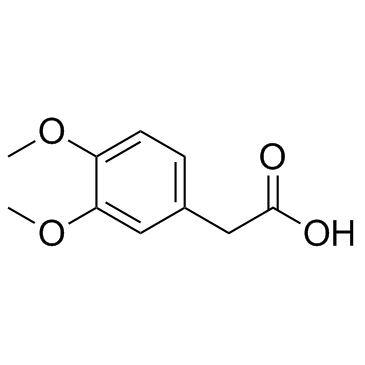 CAS#:93-40-3
CAS#:93-40-3 CAS#:64-17-5
CAS#:64-17-5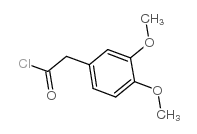 CAS#:10313-60-7
CAS#:10313-60-7 CAS#:35323-09-2
CAS#:35323-09-2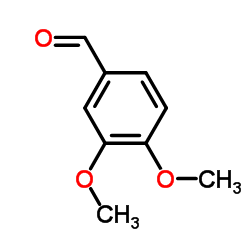 CAS#:120-14-9
CAS#:120-14-9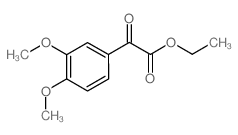 CAS#:40233-98-5
CAS#:40233-98-5 CAS#:81316-62-3
CAS#:81316-62-3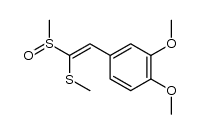 CAS#:35453-08-8
CAS#:35453-08-8 CAS#:91-16-7
CAS#:91-16-7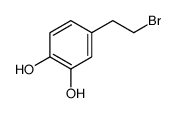 CAS#:220556-03-6
CAS#:220556-03-6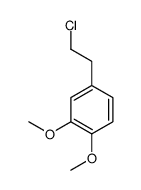 CAS#:27160-08-3
CAS#:27160-08-3 CAS#:7417-21-2
CAS#:7417-21-2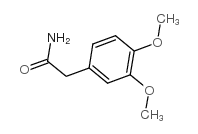 CAS#:5663-56-9
CAS#:5663-56-9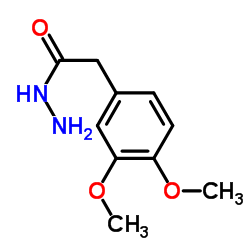 CAS#:60075-23-2
CAS#:60075-23-2 CAS#:117838-86-5
CAS#:117838-86-5 CAS#:137-07-5
CAS#:137-07-5 CAS#:139-76-4
CAS#:139-76-4 CAS#:17173-25-0
CAS#:17173-25-0
